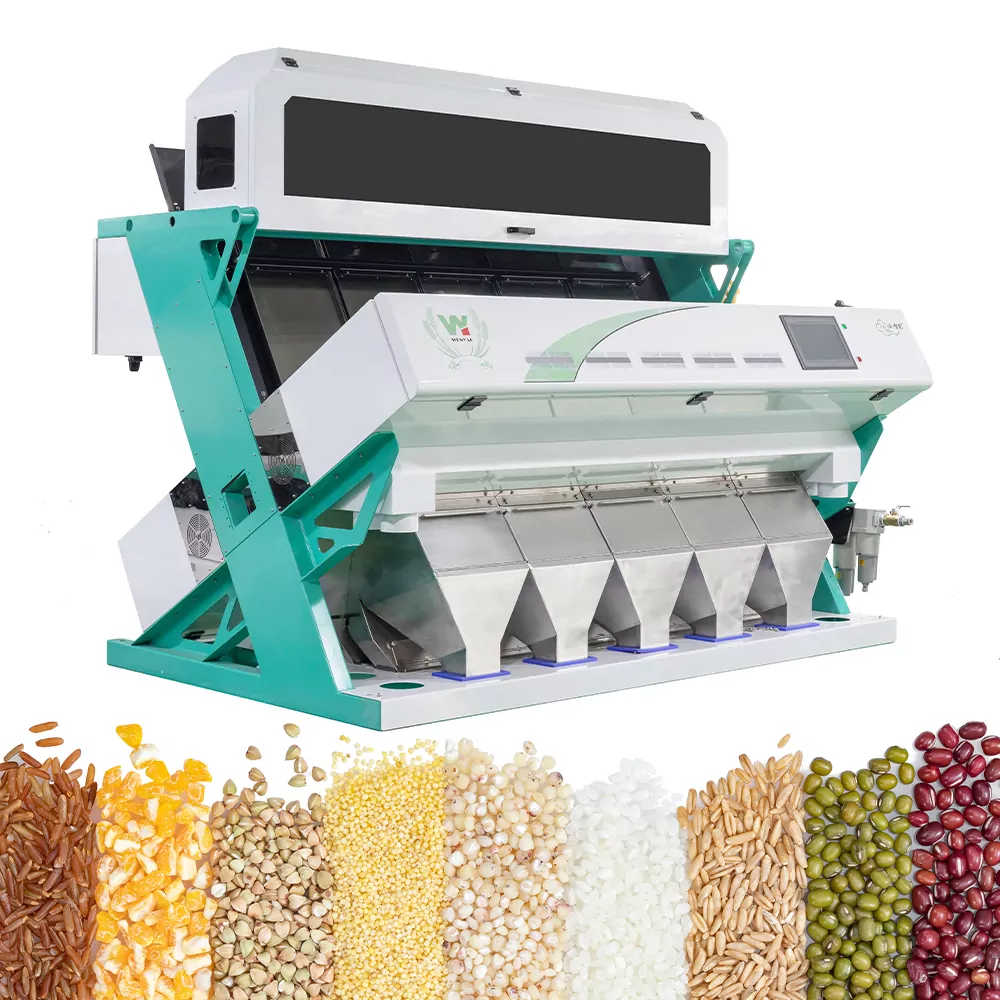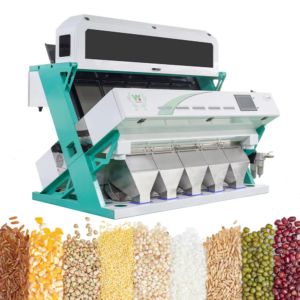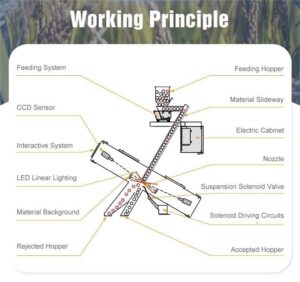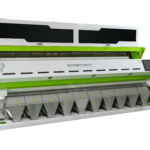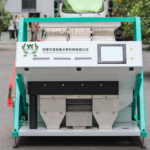Color sorting equipment plays a vital role in modern industrial production across various sectors, including food processing, plastic recycling, mining, pharmaceuticals, and other industries. Through precise sorting by color, they could achieve notable enhancement in the purity and consistency of the final products. This not only substantially elevates the level of standardized production, enabling manufacturers to easily meet stringent quality control standards and regulatory requirements, but also allows companies to command a higher market premium for their high-quality products.
Moreover, a color sorting machine effectively mitigates the risk of contaminants or defective materials entering the production process, thereby controlling supply chain risks and safeguarding the company’s reputation and financial health.
However, the crucial role of color sorting equipment is rooted in their unique working principles and meticulous processes.
In this blog, we will delve into the working mechanisms and procedures of a color sorter, uncovering the secrets behind their efficient sorting capabilities and aiding readers in better understanding and applying this advanced device.
Table of Contents
ToggleDisadvantages of the Traditional Sorting Mode
Traditional sorting modes, which often rely on manual labor and outdated equipment, have several significant disadvantages that impact various industries.
1. Limitations of Manual Sorting
- High Cost:Firstly, manual sorting is labor-intensive and time-consuming. It requires a considerable amount of human resources to perform. This can hike personnel costs and hinder operational efficiency. Moreover, the accuracy and consistency of manual sorting can vary greatly based on the skill and experience of the individual sorter.
- High Error Rate:Manual sorting is prone to errors due to fatigue, inattention, or simple human fallibility. A study published[1] in the International Journal of Engineering Research and Applications found that 80% of manufacturing defects are due to human error. Moreover, a report by the National Institute of Standards and Technology (NIST) underscores that human
- Limited Applicability:Manual sorting may not be suitable for all types of materials. Some materials may be too small, too fragile, or too hazardous for manual handling, making manual sorting impractical or unsafe.
2. Defects of Outdated Equipment
- Lack of Precision:Outdated sorting equipment may lack the precision and accuracy required for high-quality sorting. This can cause the inclusion of impurities in the final product, compromising its quality and diminishing its market value.
- High Energy Consumption:Antiquated sorting machinery may be inefficient and energy-intensive. Older machines often consume more energy and produce more waste than modern, energy-efficient equipment. This not only increases operational costs but also contributes to environmental pollution.
- Complicated Maintenance: Someequipment may be difficult to maintain and repair. Spare parts may be hard to find, and technicians may require specialized training to work on the equipment, resulting in downtime and decreased productivity.
3. Impact of Specific Industries
- Food Processing:Impurities in raw materials, such as excessive yellow rice grains, can tarnish the brand reputation and weaken customer loyalty. This, in turn, can exert a notable influence on sales and profitability.
- Plastic Recycling:Impure color separation in plastic recycling can affect the value of the recycled materials. Mixed colors can make it difficult to process and reuse plastics, lowering their market value and increasing disposal costs.
- Mining: Metal impurities mixed with concentrate in mining can elevate smelting costs drastically. These impurities can damage smelting equipment, require additional processing steps, and increase energy consumption.
Working Principle and Process of Color Sorting Equipment
At WENYAO, with 17 years of commitment to the manufacturing of intelligent color sorting equipment, we have developed robust R&D capabilities that drive innovation in sorting colors. Our color sorting equipment operates on a set of well-defined working principles and processes, which are detailed below:
1. Optical Imaging and Data Acquisition
- Multi-Spectral Scanning: Our color sorting equipment utilizes high-resolution CCD sensors to scan materials across their full width, capturing the optical characteristics of the materials. This step is fundamental for obtaining key information such as color and texture.
- Dynamic Compensation Technology: To eliminate image blur caused by material movement, our color sorter machine combines high-speed sensors with synchronous trigger devices. This technology ensures clear and stable images are captured even when materials are moving rapidly.
- Spectral Analysis: An LED light source provides stable illumination, and the system enhances the contrast between foreign matter and normal materials through multi-band spectral analysis (such as visible light and infrared). This aids in more accurately identifying materials of different colors.
2. Intelligent Identification and Decision-Making
- Multi-Dimensional Judgment Criteria: Our color sorting equipment not only identifies color differences but also detects shape irregularities and analyzes complex defects such as mold, insect infestation, and metal impurities. This comprehensive detection capability promises high-quality materials.
- Personalized Configuration: Given the unique characteristics of each material, like shape and color, and the diverse conditions that even the same material can present under different circumstances, we offer personalized configuration services for our smart sorting equipment based on the customer’s actual needs, promising the optimal color sorting activities.
3. Accurate Execution and Sorting
- Precision Ejection Mechanism: When the color sorting equipment detects non-conforming products, the high-frequency ejection system swiftly responds to precisely remove these items. The optimized fluid mechanics warrant that adjacent qualified products remain unharmed during the ejection process.
- Multi-Channel Collaboration: Our WENYAO sorting equipment supports the simultaneous operation of multiple channels, permitting the concurrent processing of multiple materials or different grades of products.
4. Data Monitoring and Self-Optimization
Our WENYAO smart sort machine is equipped with a data monitoring system that continuously tracks the sorting performance in real time. It automatically adjusts the sorting parameters based on the sorting outcomes to optimize the efficiency and accuracy of the sorting process.
Advantages of WENYAO Color Sorting Equipment
1. Precision Dimension
With a resolution of 0.02mm², compared to the industry average of 0.05mm², our sorting equipment, like rice color sorter, provides a more refined sorting capability, assuring higher product purity and fulfilling stricter quality requirements.
2. Processing Efficiency
The single channel has an 8-ton-per-hour throughput and supports multi-channel parallel connections, enabling our sorting equipment to adequately address the needs of large-scale industrial production, markedly improving production efficiency and reducing the sorting cost per unit product.
3. Durability Index
The ejection valve life exceeds 500 million cycles, and the LED light source is maintenance-free for 50,000 hours. These durability indicators sustain the long-term stable operation of our sorting equipment, reducing maintenance and replacement costs and enhancing the economic benefits of the equipment.
4. Hygiene Standard
The food-grade 304 stainless steel contact surface is in line with HACCP certification requirements, indicating that our sorting equipment satisfies high standards for hygiene and safety, making it suitable for industries with stringent sanitary conditions, such as food processing.
5. Maintenance of Color Sorting Equipment
- Regular Equipment Cleaning: To maintain the cleanliness of sensors and nozzles, regular cleaning of the sorting equipment is necessary. This helps maintain high performance and extends the lifespan of the equipment.
- Check Operating Status: Regularly check the operating equipment status and address faults in a timely manner to guarantee steady operation and minimize the risk of production interruptions.
Conclusion
As an essential tool in modern industrial production, color sorting equipment has made important contributions to improving production efficiency, product quality, and risk management. As technology continues to evolve, it may bring more value and competitive advantages through expanded application scope and enhanced efficiency.
Whether you’re in food processing, plastic recycling, mining, pharmaceuticals, or any other industry that relies on precise sorting, our sorting equipment is tailored to meet your specific needs. Contact us today and let our customized solutions enhance your operations.
Reference
[1]. Available at:
https://pluto-men.com/human-error-persistent-challenge-manufacturing-operations/


